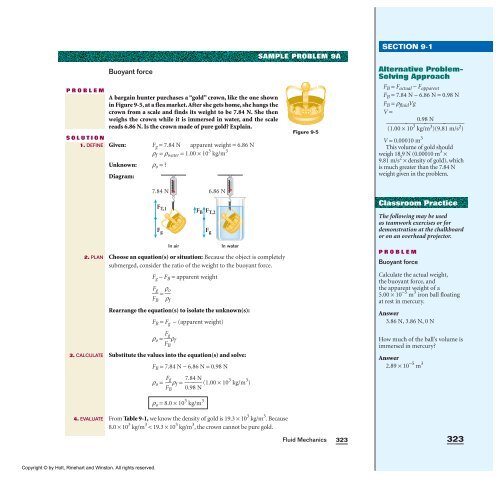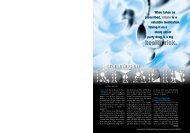Create successful ePaper yourself
Turn your PDF publications into a flip-book with our unique Google optimized e-Paper software.
PROBLEM<br />
SOLUTION<br />
1. DEFINE<br />
2. PLAN<br />
3. CALCULATE<br />
4. EVALUATE<br />
Buoyant force<br />
A bargain hunter purchases a “gold” crown, like the one shown<br />
in Figure 9-5, at a flea market. After she gets home, she hangs the<br />
crown from a scale and finds its weight to be 7.84 N. She then<br />
weighs the crown while it is immersed in water, and the scale<br />
reads 6.86 N. Is the crown made of pure gold? Explain.<br />
Given: F g = 7.84 N apparent weight = 6.86 N<br />
r f = r water = 1.00 × 10 3 kg/m 3<br />
Unknown: r o = ?<br />
Diagram:<br />
Copyright © by Holt, Rinehart and Winston. All rights reserved.<br />
7.84 N 6.86 N<br />
F T,1<br />
F g<br />
Choose an equation(s) or situation: Because the object is completely<br />
submerged, consider the ratio of the weight to the buoyant force.<br />
F g − F B = apparent weight<br />
Fg<br />
⎯⎯<br />
= ⎯<br />
FB<br />
ro<br />
⎯<br />
rf<br />
Rearrange the equation(s) to isolate the unknown(s):<br />
F B = F g − (apparent weight)<br />
Fg<br />
ro = ⎯⎯rf FB<br />
Substitute the values into the equation(s) and solve:<br />
F B = 7.84 N − 6.86 N = 0.98 N<br />
Fg<br />
ro = ⎯⎯rf = ⎯<br />
FB<br />
7.<br />
84<br />
N<br />
⎯ (1.00 × 10<br />
0.<br />
98<br />
N<br />
3 kg/m 3 )<br />
r o = 8.0 × 10 3 kg/m 3<br />
FB FT,2 From Table 9-1, we know the density of gold is 19.3 × 10 3 kg/m 3 . Because<br />
8.0 × 10 3 kg/m 3 < 19.3 × 10 3 kg/m 3 , the crown cannot be pure gold.<br />
F g<br />
In air In water<br />
SAMPLE PROBLEM 9A<br />
Figure 9-5<br />
<strong>Fluid</strong> <strong>Mechanics</strong><br />
323<br />
SECTION 9-1<br />
Alternative Problem-<br />
Solving Approach<br />
FB = Factual − Fapparent FB = 7.84 N − 6.86 N = 0.98 N<br />
FB = rfluidVg V =<br />
0.98 N<br />
⎯⎯⎯⎯<br />
(1.00 × 10 3 kg/m3 )(9.81 m/s2 )<br />
V = 0.00010 m 3<br />
This volume of gold should<br />
weigh 18.9 N (0.00010 m 3 ×<br />
9.81 m/s 2 × density of gold), which<br />
is much greater than the 7.84 N<br />
weight given in the problem.<br />
Classroom Practice<br />
The following may be used<br />
as teamwork exercises or for<br />
demonstration at the chalkboard<br />
or on an overhead projector.<br />
PROBLEM<br />
Buoyant force<br />
Calculate the actual weight,<br />
the buoyant force, and<br />
the apparent weight of a<br />
5.00 × 10 −5 m 3 iron ball floating<br />
at rest in mercury.<br />
Answer<br />
3.86 N, 3.86 N, 0 N<br />
How much of the ball’s volume is<br />
immersed in mercury?<br />
Answer<br />
2.89 × 10 −5 m 3<br />
323
















